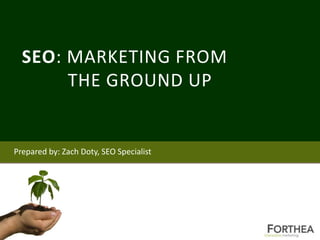Seo marketing-from-the-ground-up
- 1. SEO: MARKETING FROM THE GROUND UP Prepared by: Zach Doty, SEO Specialist
- 2. TABLE OF CONTENTS ŌĆó The concept behind SEO ŌĆó SEO is notŌĆ” ŌĆó SEO is: ŌĆó The process behind SEO ŌĆó Research & competition ŌĆó Strategy & execution ŌĆó What does SEO mean for bloggers? ŌĆó Reaching out to others ŌĆó 3 things you can do tomorrow ŌĆó Wrap up
- 3. What do you think SEO is?
- 4. SEO is notŌĆ” Spam Buying links
- 5. SEO is: Providing a relevant answer to a searcherŌĆÖs question.
- 6. SEO is: Attracting previously unreached customers, readers and relationships.
- 7. SEO is: Being first in the mind of the audience. Paid Search Ads Paid Search Ads Unpaid ŌĆ£OrganicŌĆØ Search Results
- 8. Now We Know What Basic SEO IsŌĆ” ŌĆ”How do we go about it?
- 9. First: Research & Competition ŌĆó What do you want to achieve? ŌĆó Extreme couponing readers? ŌĆó Facebook fans for meals on a budget?
- 10. First: Research & Competition ŌĆó Phrases that say what you do, not who you are ŌĆó E.g., ŌĆ£Extreme Couponing HoustonŌĆØ
- 11. First: Research & Competition ŌĆó Who is standing in your way, how can you beat them? ŌĆó Who else is optimizing for your target terms? ŌĆó Enter a fight you can win
- 12. Strategy & Execution ŌĆó Pick one or two unique, but related keywords to use on each page ŌĆó Meta Tags Meta Title Meta Description
- 13. Strategy & Execution ŌĆó Use the same keywords from the Meta tags on site ŌĆó Content, Links between your siteŌĆÖs pages
- 14. Strategy & Execution ŌĆó Branch Out From Your Site ŌĆó Build relationships with other sites ŌĆó Build relationships on social media
- 15. What does SEO mean for bloggers?
- 16. ThereŌĆÖs A Lot To Gain ŌĆó Readers ŌĆó Advertising Dollars ŌĆó Bloggers ŌĆó Grow Your Personal Brand ŌĆó Commercial Brands ŌĆó Product reviews, Advocacy
- 17. 3 Things You Can Do Tomorrow 1. Use Wordpress? Install an SEO plugin and find some keywords to pursue. ŌĆó Yoast SEO ŌĆó All in One SEO Pack 2. Pick off link opportunities from a competitor. ŌĆó Link Diagnosis 3. Consult the expertsŌĆ”Google! How ŌĆó Free: relate to your customer in their inbox? do we Google Analytics ŌĆó Free: Google Webmaster Tools
- 18. Zach Doty SEO Specialist zdoty@forthea.com @Forthea @ZLDoty Have questions, want to learn more SEO? Email me!
Editor's Notes
- #3: Brief agendaTime for questions at the end
- #4: Gather impressions & reactions first Mashable articles, seen as a skill on a friend of a friendŌĆÖs LinkedIn profile?- The Google algorithm that helps people find what they want & need
- #5: Not cramming as many words as possible into a pageNot blanketing irrelevant sites with questionable links
- #6: Timely information that helps solve a problemEngagingcontent on site that tells about what you do AND who you are
- #7: Gain new customers, loyal readersBuild relationships off site with links, on site with engagement, social proof
- #8: Finding balance to meet a specific need for a customer/reader AND the businessFinding balance between marketing on site and off siteWhen done right, itŌĆÖs a win-win
- #9: Just covered two basic parts of solid SEO, but there is MUCH more to tellThe ŌĆ£ResumeŌĆØ: Getting an interview with Google, being hired by the searcher.
- #10: ItŌĆÖs common sense to outline any plan for your blog or businessWhat you want to achieve determines how you proceed
- #11: See what is ranking highly for your term (Are there common threads in the top 10?)Related searches to find new ideas
- #12: Sure, you can optimize for Houston Blogger (but why would you?)Not all search terms are equal.Shoot for higher volume, lower competition if possibleThe allintitle operator
- #13: Meta tags: Do you know what they are?Seen only in the source code right? Wrong.Not a heavy portion of ranking, but important to draw in a reader.
- #14: On Page: This is often the first step. Very few people get to it, much less get it right.Position of keywords do matter. YouŌĆÖre writing from two audiences.Google ranks you, but doesnŌĆÖt count toward Facebook likes or Advertising dollars.
- #15: Site relationships: Links, relevant traffic, mutual benefitFind new sites, readers through social. Be personal, not automated!Why? ItŌĆÖs good business for you and your site.
- #16: Start by gauging impressionsMashable articles?
- #18: Wordpress SEO plugins: There are lots of good ones. Pick (only) one and use it.Search for a non-brand term, see who ranks in the top 3. Search their URL in Link Diagnosis.See what people do on your site, how they get there. See what Google sees.


















